How I learned to love backpacking?
Let me start by saying, I’m not a backpacker. I love to hike and car camp or even glamp. But backpacking? No. Emphatically NO. But then came the Fjallraven Classic Sweden. The tagline says, “Journey through one of Europe’s last wildernesses with everything you need on your back. Over 110km prepare to meet like-minded fellow trekkers, the occasional reindeer herd and mountains that roll into the horizon.”
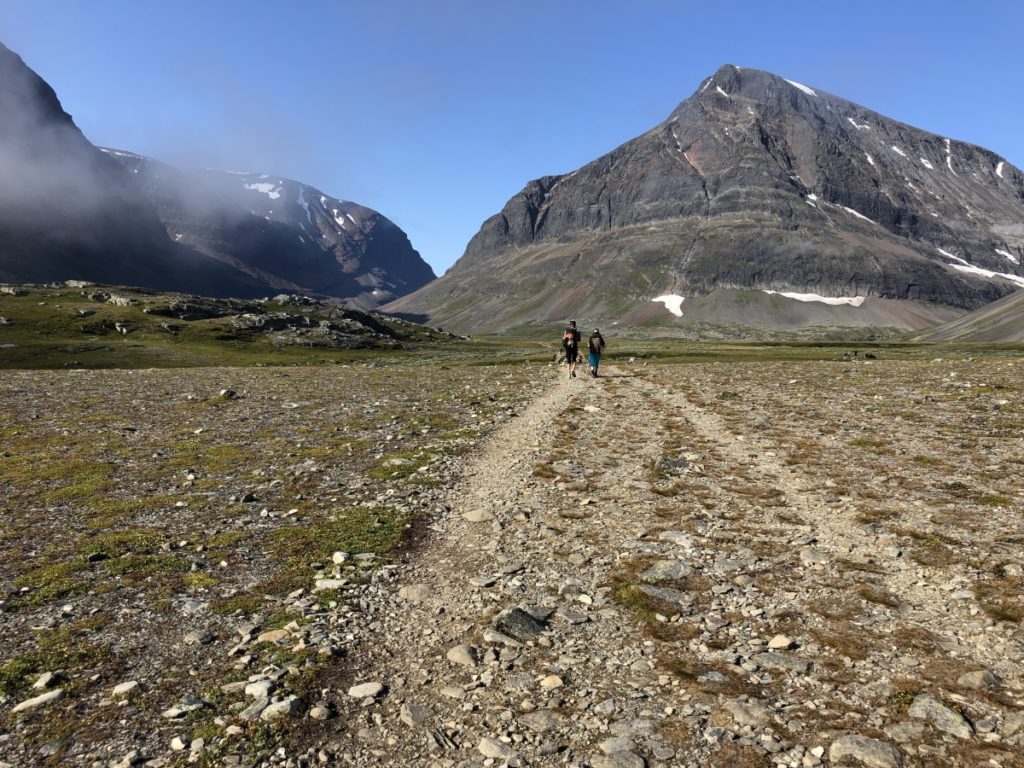
How could I resist? The Fjallraven Classic lured me in with awe-inspiring pictures, the security of a brand “sponsoring” a hike, and the promise of exploring a wilderness that sounded sexy and wild. Sign me up! Me and 2000 other intrepid souls prepared to backpack come mud, snow, and anything in between. I was inspired by the prospect of seeing moose and reindeer and getting to say I’d hiked through the Arctic.
Fjallraven, you had me from hello. So this is how I learned to love backpacking. From a girl who had never camped alone or hiked more than one day alone to one who is now actively planning to do it as much as she can. Thank you Fjallraven! To those of you contemplating this great adventure, I hope I can help make it a little bit less of an “adventure.”
“Adventure is just bad planning.”
― Roald Amundsen
Even Backpackers might get the blues
First – this is a serious backpacking experience. Don’t let the fact that it’s sponsored by Fjallraven, a gear company, and that the event is open to anyone, fool you into thinking otherwise. The Fjallraven Classic will challenge you. Preparation is key to not only surviving but thriving – and truly enjoying this hike. I made the grave mistake of not training for this. I paid for it in sore muscles and a wicked cold at the finish.
Preparing for the hike
Put some miles on your boots and pump some iron!
With all respect to Fjallraven they warned us this was no walk in the park. If you’re one of the lucky ones to get a spot on the hike (tickets sell out in a couple of hours), you’ll get plenty of advice from Fjallraven both on the Classic website and in newsletters leading up to the hike. There’s also a (mostly) very friendly group on Facebook who will answer your questions with great advice even if you’re a newbie and you’re asking something you should probably already know. I mean, come on, if you have to ask whether you should wear your new boots for the first time on the Classic …well maybe you should reconsider if this hike is for you?
Best advice? Start upping your workout at least 4 months out from the hike. This means gradually gaining strength and fitness so you’re doing a couple of short hikes each week (6-10 k) and one long hike on the weekend with a pack (15-20 K / 10 kilos) at least 2 months before the hike. Include strength training for arms, legs, and core. You’ll be thankful you did when at the end of each day you have the energy to socialize with your fellow hikers (and set up your campsite and cook dinner – bonus, attending to hygiene).
Beg, borrow, or buy good equipment – it’s worth every penny!
So I heard the most outrageous story the day before departure in Nikkaluokta. One guy hiked the trail last year with a duffle bag and carried two plastic shopping bags. Don’t be that guy! Also, judging by the stories I heard about the treacherous weather in 2018 and the amount of hardship, I can hardly believe it. I don’t know if this guy made it. (I also don’t know if this is one of the Fjallraven Classic, “urban” legends). If anyone can enlighten me on this story and if it’s true (pictures appreciated) – please do!
For once in my life, I packed literally everything I needed for a trip. It all worked perfectly (except for one item, to be revealed later). I pulled out all the stops to make sure I would be safe, warm, and comfortable. Je ne regrette rien. Yes, my pack was 13.5 kilos and I would’ve loved it to be around 10. But if the weather had taken a really bad turn? Let’s just say, I prefer some extra weight to hypothermia. Even though it’s apparently not a bad way to go. You fall asleep quite peacefully after the initial painful freezing of extremities…
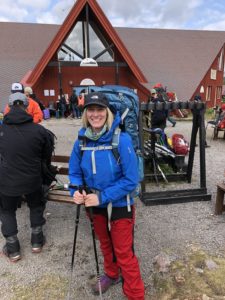
Anyway, prepare to be shamed repeatedly by those who carry less. An annoying game of kilo competition begins as soon as you join the Facebook page and builds to become particularly intense on start day. I had one man ask me my pack weight and when it was the same as his he began to go into a long list of excuses as to why he had so much weight. Finally, I looked at him and said, please stop – you’re stressing me out. We’ll be fine. I felt a little like a psychologist giving a motivational talk. Don’t listen to everyone. Do you. (Don’t go nuts on weight either).
Best advice? A loaded backpacking pack should not weigh more than about 20 percent of your body weight. Ok, so mine was slightly higher but what you don’t know can’t hurt you, right? (It did hurt, a bit). How to pack? I benefited from research, talking to friends, and advice from the Classic community. And yes, I brought my Kindle.
During the Hike
Take care of your feet – they’ll be what get you to the finish!
By the end of the hike, most people’s feet were a mess. Now, this is a combination of the harshness of the terrain, bad boots, and bad footcare. You will be subject to at least one of these problems and if you hit the trifecta, you’re gonna be in trouble. It could even cause you to drop out of the Classic. And when I say drop out, I really mean be airlifted out. Because once you start the hike in this roadless area no cars can go there. It’s either rescue by your feet or by helicopter. This is the Arctic Circle. This is a true wilderness. So if you don’t want to pay for an expensive helicopter ride or limp out in disgrace – take good care of your feet.
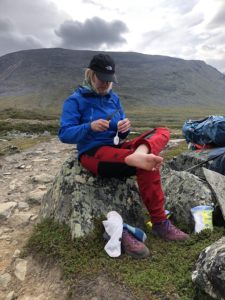
I bought new boots two weeks before the hike. Wait a minute! I didn’t end up wearing them on the hike, thankfully. But I almost did. Disaster is the word that comes to mind. I ended up in my tried and true old hikers and for the most part, they worked just fine. I ended up with one blister and a painfully tender little toe. For the blister, I ignored a hot spot for probably one hour too many. The little toe pain was most likely because the shoes were just a bit too worn out and because the trail was 110 kilometers of rocks (with some sweet relief provided by stream crossings and wooden planks). I’m not talking shale (although there is several kilometers of that after Tjaktja pass) – I’m talking a combination of big – small, – jagged rocks dispersed along the trail in such a way as to confound you as to where to put your feet. One too many times my foot slipped into the gap between rocks and was painfully compressed. If you don’t want to fall or twist an ankle you will spend 99% of your time looking at the trail below you. Tip: make sure you stop a lot to look at all the gobsmacking beauty around you – I do mean actually stop as it’s best not to walk this trail without looking at your feet!
Best advice? Stop every 1-2 hours and completely remove your socks and boots and if available, stick your feet into one of the icy cold streams you will pass by. I’m sure this saved my feet.
The weather is unpredictable – prepare for Anything!
In 2019 we were lucky. According to Fjallraven Classic yore, 2018 was a year for the record books. I heard stories of driving rain, waking up to snow and a record number of heli rescues. Again, this is the Arctic! This latitude is notorious for creating explorers like Amundsen and Nansen. Tough guys who spent months exploring the Antarctic before there was Gore-tex. Scandinavians have a saying, “there’s no such thing as bad weather, only bad clothing.” It’s true. Mostly.
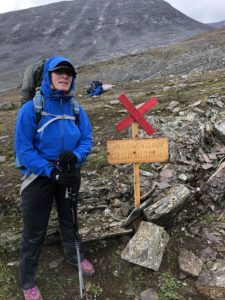 I was prepared for anything. I’m glad I was too because when the rain and sleet came down while I crossed the Tjaktja pass, I only had to concentrate on putting one foot in front of the other and not on whether I was going to freeze to death. I also knew that if I had to I could set up my tent and survive the night, either on the pass or anywhere else. Although I can tell you I made sure to not only hike the pass but to continue for several kilometers after so I could camp out of the bitterly cold winds gusting near the pass.
I was prepared for anything. I’m glad I was too because when the rain and sleet came down while I crossed the Tjaktja pass, I only had to concentrate on putting one foot in front of the other and not on whether I was going to freeze to death. I also knew that if I had to I could set up my tent and survive the night, either on the pass or anywhere else. Although I can tell you I made sure to not only hike the pass but to continue for several kilometers after so I could camp out of the bitterly cold winds gusting near the pass.
Best advice? Layers. Bring a clothing system that allows you to go from 17 degrees (celsius) down to 0, and anything in between. Also, don’t forget your nights will be cold. Bring a suitable sleeping bag. I also brought a silk sleeping bag liner. This makes the bag adaptable to warm or very cold nights.
Trail Hacks to help you get the most out of the Fjallraven Classic
Camping
There are a lot of people on the trail. Not all the time, mind you – but by the time you get to the end of your day most times, there will be. It helps if you plan your camps a bit ahead with whatever intel you can find. Some parts of the trail have long stretches where the ideal or even decent campsite is hard or impossible to find. So people tend to pitch a lot of tents in one spot. It’s noisy.
Best advice? If you’re looking for some peace and quiet or a wilderness experience you’ll need to begin looking for your spot early or plan ahead. Leave yourself enough time and energy at the end of the day to pick a great camping spot. This is one of the highlights of backpacking after all. Camp!
Water
Yes, there is water all along the trail. It’s in the form of beautiful, ice-cold glacial streams. However, flowing water (the only safe kind) can be far away the moment you realize you drank your last drop and you don’t have the energy or didn’t have the foresight to fill up your canteen at that last stream. Being from the US, I never trust water without filtration. This time I did. The water is not only safe, it’s delicious. I spent one late afternoon and night without water because I ran out after the pass and didn’t fill up at the checkpoint. Big mistake. No dinner for me that night. I’ve never been so happy to see a river the next morning after a couple of hours hiking dry.
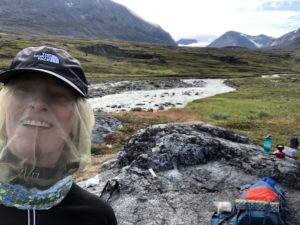
Best advice? Read the map and keep your canteen filled – all the time. Splurge and carry 2 liters, just in case – and especially at the end of the day when you may be too tired to hike that extra 1 or 2 k down to the stream to fill up.
Equipment
So as I said before I really went all out buying equipment for this trek. Since I had only backpacked twice before in my life and that had been a good 15 years before, I did a lot of research and actually packed really well. However, I didn’t take all my equipment out for a test run before the hike (I mean a real-world test run overnight). I set up the tent in my living room and put together my poles, fired up my Jetboil, and tested my new airbed – but I didn’t test Everything. This was a mistake. I had a new 3L Camelback that went straight out of the packaging and into my backpack. Oy! I found out the suction didn’t work on the trail – after filling it with water. Luckily, I had my water bottle – but it sure would’ve been nice to have that extra few liters to drink on the go.
Best advice? Seriously, do an overnight with your entire kit – in the outdoors. Test everything. I mean Everything.
Fjallraven Perks
Oh Fjallraven! – I love you! This ticket has got to be the best bargain out there for an adventure. The most delicious freeze-dried food is included, gas for your stove, maps, great volunteers to check you in and out along the way and some tasty and thoughtful extras at the checkpoints for a surprise to keep spirits up. There are even sauna tickets included at a few checkpoints that you can use at the mountain huts along the trail.
Best advice? Take advantage of all that Fjallraven offers at each checkpoint. Don’t forget a sauna ticket (especially the one at the last checkpoint in Kieron – as I did) You’re really going to want to use it so you can blast into the finish shiny and semi-clean. Also, timing is everything, saunas along the trail aren’t fired up until 16:00 so time your hike accordingly.
Will I do the hike again? I don’t know. But it’s not because it was too hard or not beautiful enough – it’s because there are 6 Classics and I want to do them all!
People initially come to participate in the hike to experience a landscape that is jaw-droppingly gorgeous and to test themselves. People return over and over because of the community and the special bond we all share during Fjallraven Classics. I highly recommend it.
In the words of Roald Amundsen –
“I may say that this is the greatest factor: the way in which the expedition is equipped, the way in which every difficulty is foreseen, and precautions taken for meeting or avoiding it. Victory awaits him who has everything in order, luck, people call it. Defeat is certain for him who has neglected to take the necessary precautions in time, this is called bad luck.”
Happy Hiking!
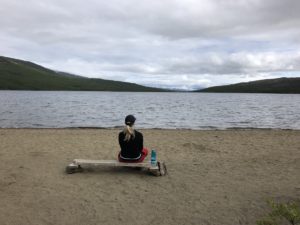
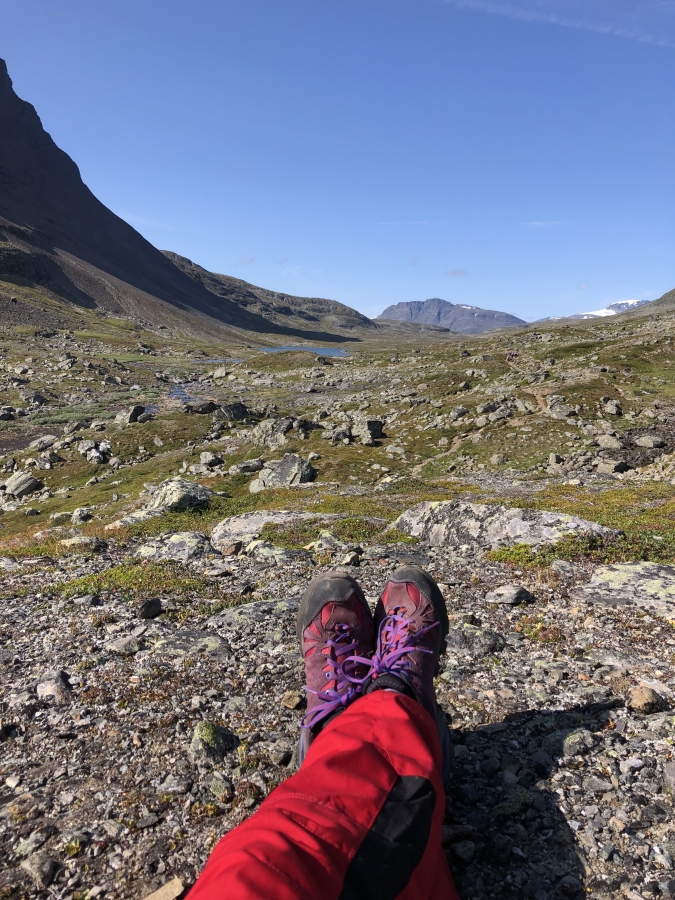
2 thoughts on “Hiking the Fjallraven Classic – How I Learned to Love Backpacking.”
The 4 km route of rocks at Tjaktja pass was killing, plus the wind! Those were the time the helicopter cannot come and save you even you were willing to pay. Good memories after all. I told myself along the route that it’s just a matter of time, fast or slow, but the checkpoint is anyway waiting for me. Thanks to the late sunset time so we didn’t need to walk with the torch on.
Also, I used to think the sauna tickets are something extra that need to pay. Will definitely prepare for that next time, as semi clean is well good enough.
Hi Joe – Yeah, those rocks after the pass were definitely hardcore! Now that it’s been a few weeks though I don’t quite remember how hard it was just that is was amazing and I want to go back! Next time, I’ll plan well for saunas – that last one in Abisko was definitely refreshing! Happy Hiking!